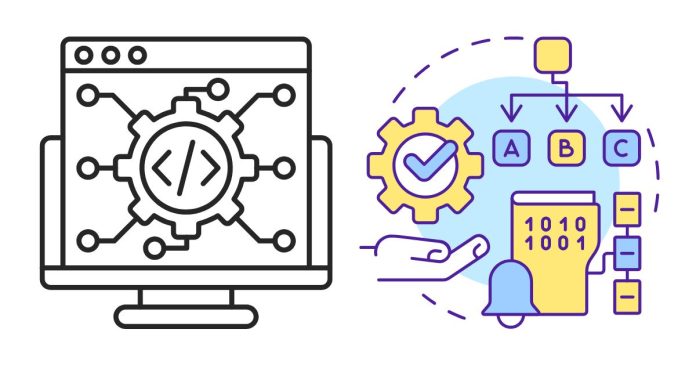Linear Programming (LP) is a mathematical method used for optimizing a particular objective (such as maximizing profit or minimizing cost) under a set of linear constraints. It involves making decisions to allocate limited resources effectively.
Key Components of Linear Programming
- Objective Function:
A linear equation that represents the goal of the problem, e.g., maximize profit or minimize cost.
Example:Z=c1x1+c2x2+…+cnxnZ = c_1x_1 + c_2x_2 + \ldots + c_nx_nwhere ZZ is the objective function, cic_i are coefficients, and xix_i are decision variables.
- Decision Variables:
The variables that represent the quantities to be determined (e.g., number of products to produce). - Constraints:
A set of linear inequalities or equations that represent the limitations or restrictions on resources.
Example:a1x1+a2x2+…+anxn≤ba_1x_1 + a_2x_2 + \ldots + a_nx_n \leq b
- Non-Negativity Restriction:
Decision variables must be greater than or equal to zero.
Example:x1≥0, x2≥0, …x_1 \geq 0, \, x_2 \geq 0, \, \ldots
Formula for Linear Programming
A general LP problem can be formulated as follows:
Objective Function:
Maximize or Minimize Z=∑i=1ncixi\text{Maximize or Minimize } Z = \sum_{i=1}^{n} c_i x_i
Subject to Constraints:
∑i=1naijxi≤bjfor j=1,2,…,m\sum_{i=1}^{n} a_{ij} x_i \leq b_j \quad \text{for } j = 1, 2, \ldots, m xi≥0for i=1,2,…,nx_i \geq 0 \quad \text{for } i = 1, 2, \ldots, n
Where:
- ZZ = Objective function.
- cic_i = Coefficients of decision variables in the objective function.
- xix_i = Decision variables.
- aija_{ij} = Coefficients of constraints.
- bjb_j = Resource availability (constraints).
- mm = Number of constraints.
- nn = Number of decision variables.
Examples of Linear Programming
Example 1: Maximize Profit
Problem Statement:
A factory produces two products, x1x_1 and x2x_2. Each unit of x1x_1 generates a profit of $50, and each unit of x2x_2 generates $40. Manufacturing each unit requires the following resources:
- Machine A: 2 hours for x1x_1, 1 hour for x2x_2 (maximum 100 hours available).
- Machine B: 1 hour for x1x_1, 2 hours for x2x_2 (maximum 80 hours available).
Find the number of units of x1x_1 and x2x_2 to maximize profit.
Formulation:
- Objective Function:
Maximize Z=50×1+40x2Z = 50x_1 + 40x_2 - Constraints:
2×1+x2≤100(Machine A constraint)2x_1 + x_2 \leq 100 \quad \text{(Machine A constraint)} x1+2×2≤80(Machine B constraint)x_1 + 2x_2 \leq 80 \quad \text{(Machine B constraint)} x1≥0, x2≥0(Non-negativity)x_1 \geq 0, \, x_2 \geq 0 \quad \text{(Non-negativity)}
Solution: Using graphical or simplex methods, you would solve for x1x_1 and x2x_2 that maximize ZZ.
Example 2: Minimize Cost
Problem Statement:
A company needs to transport goods from two warehouses to three retail stores. The cost per unit of transportation and the supply and demand at each location are given. Minimize the total transportation cost.
Formulation:
- Objective Function:
Minimize Z=∑i=12∑j=13cijxijZ = \sum_{i=1}^{2} \sum_{j=1}^{3} c_{ij} x_{ij} - Constraints:
- Supply constraints for each warehouse.
- Demand constraints for each retail store.
- Non-negativity constraints.
Solution:
This is solved using methods like the Transportation Algorithm.
Applications of Linear Programming
- Business and Economics:
- Maximizing profit.
- Minimizing production costs.
- Operations Research:
- Resource allocation.
- Transportation problems.
- Manufacturing:
- Scheduling tasks.
- Product mix optimization.
- Logistics:
- Supply chain management.
- Network flow problems.
Solving Techniques
- Graphical Method (for 2 variables): Plot constraints on a graph to find the feasible region and optimize the objective function.
- Simplex Method: A step-by-step algorithm used for more than two variables.
- Software Tools:
- Excel Solver.
- Programming languages like Python (using
PuLPorSciPy).
Let me know if you’d like examples of solving LP problems using Python or Excel! 😊


